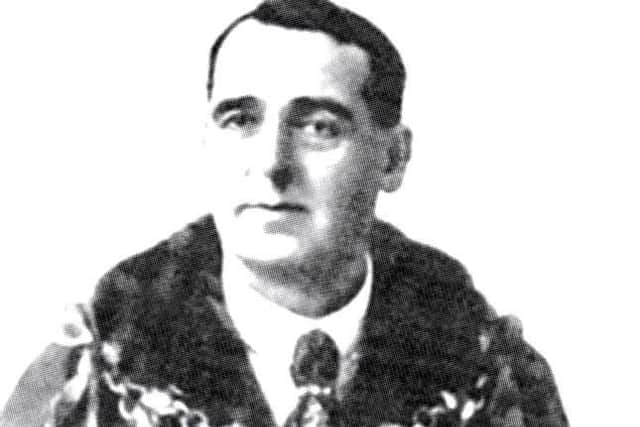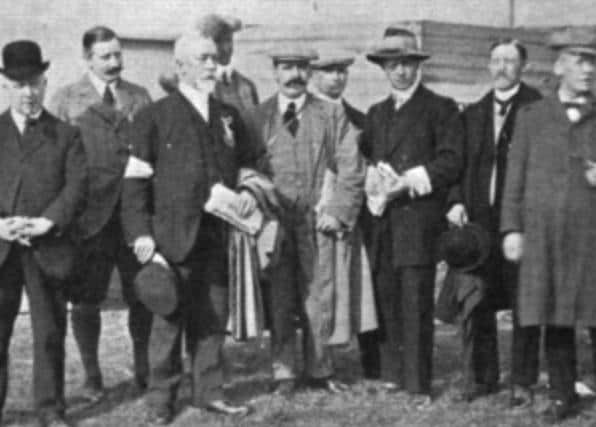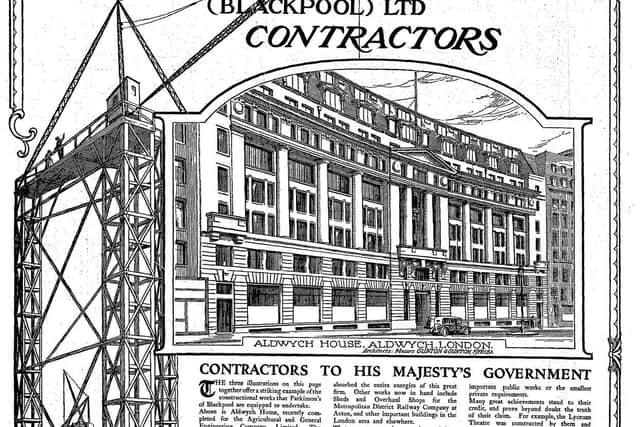How Sir Albert left his mark on Blackpool
and live on Freeview channel 276
Lector Si Monumentum Requiris Circumspice reads the elegant epitaph on Sir Christopher Wren’s impressive tomb in Saint Paul’s Cathedral in London.
It translates as: Reader if you seek his monument look around you.
Advertisement
Hide AdAdvertisement
Hide AdSuch a sentiment could also be applied to one of the resort’s greatest ever entrepreneurs and benefactors, Sir Albert Lindsay Parkinson, who was born 150 years ago.


Here was a businessman who has left his mark on everything from Blackpool Football Club, Squires Gate Airport, the former Miners’ Home but, perhaps more importantly, Stanley Park.
Born at Hastings Place, Lytham on 24 February, 1870, Albert Lindsay Parkinson, was one of seven children, four boys and three girls of Jacob Parkinson and his wife, Mary.
He spent his formative years in the resort when his parents took charge of a boarding house.
Advertisement
Hide AdAdvertisement
Hide AdAs a youngster, needing to earn pocket money, he became a programme seller at Charles Weldon’s Circus which operated at the bottom of Albert Road, on the site of the Clarence Hotel’s bowling green.


He also worked at the Raikes Hall Pleasure Gardens and Aquarium, opened in May 1882.
As well as hosting Blackpool’s first public ballroom, this celebrated and once hugely popular venue boasted a race course, football pitches, cricket pitch, skating rink, an aviary, a monkey house, a theatre and even a switchback ride.
Having experienced the venue at first hand, Parkinson would later become a shareholder, adding it to his extensive and ever expanding portfolio of major local interests.
Advertisement
Hide AdAdvertisement
Hide AdIn the meantime, having left school at the age of fourteen, he joined his father and brothers in their joinery business, initially tucked away just off Central Drive. They soon began to expand, adding a saw mill, and moving to bigger premises on Kent Road.


Taking overall charge of the company in 1896, following the death of his father in 1902, Lindsay Parkinson then became its managing director, turning it into a limited company.
With brother William taking charge of its day-to-day running, they quickly established a reputation for being able to complete any assignment on time and, most importantly, on budget.
In Blackpool, the company famously built the Talbot Hotel in a mere seven weeks while, further afield, having completed the Theatre Royal in Newcastle-upon-Tyne, their subsequent entertainment venues included the Princes Theatre in London, completed in 1905. They followed this with the refurbishment of the capital’s Lyceum Theatre.
Advertisement
Hide AdAdvertisement
Hide AdAmong a number of roller skating rinks, they built one in Paris. While the company’s headquarters firmly remained in the resort, an office was opened in Newcastle in 1902, followed three years later by an impressive London headquarters, Lindsay House in Shaftesbury Avenue.
The company’s first £1 million contract, came courtesy of Lancashire County Council. This, an extensive new asylum, based at Whalley, opened in 1915.
One of the first locals to own a motor car, Parkinson also became increasingly fascinated with flying.
Inspired by the Flying Week he attended at Rheims in France early in 1909, joining with fellow Councillor, Alderman Bickerstaffe, the duo initially set up a meeting with the Aero Club in London before travelling to France to enter into contracts with Europe’s leading aviators.
Advertisement
Hide AdAdvertisement
Hide AdLinking up with Lord Northcliffe and the Daily Mail, in October, only six years after Orville and Wilbur Wright had made the first mechanical flight, Blackpool proudly played host to the country’s first official aviation meeting.
Taking place on land leased from the Clifton Estate at Squires Gate, some two hundred unemployed men worked day and night to erect hangars and grandstands and prepare the circuit.
When the meeting opened on 18th October, the first to make a start was local aviator, A.V. Roe.
Sadly, a wire stay broke loose and his machine failed. Instead, the first to fly was Henri Farman, who had set the first official British record with a flight measuring over forty seven miles. He went on to claim the £2,000 first prize for completing the greatest number of circuits without touching the ground.
Advertisement
Hide AdAdvertisement
Hide AdDespite the high winds and poor weather, as holiday makers deserted the promenade for Squires Gate, the large crowds, estimated to be in excess of 200,000, guzzled some 36, 000 bottles of beer, 40, 000 bottles of mineral water, 500 cases of champagne and 600 cases of whisky. Five hundred hogsheads, a 1,000 hams, 2,000 pork pies and endless sandwiches were also consumed.
With the Aviation Week repeated in 1910, albeit far less successfully, twelve months later the site was taken over for a new racecourse labelled Clifton Park. Constructed by Parkinson’s company, its newly built impressive grandstand would be the first time reinforced concrete was used in a major construction.
Ernie Piggott, Lester’s grandfather once won the Clifton Park International Hurdle.
Hugely ambitious but badly financed, sadly the course was too short to qualify for a flat racing licence and it closed in 1915.
Advertisement
Hide AdAdvertisement
Hide AdMr Reid Walker was the owner who won the final event, a three mile Hunter Handicap Chase with his horse, Red Robin.
During the First World War, the site was then given over to the military, becoming the extensive King’s Lancashire Military Convalescent Hospital.
Throughout the First World War Parkinson’s company went from strength to strength aiding the war effort by supplying ammunition boxes.
They also won contracts to build two new aerodromes in 1916 and 1917, while also extending and refurbishing numerous others.
Advertisement
Hide AdAdvertisement
Hide AdIt was at this time that that they began developing the Parkinson-Kahn reinforced concrete house designs.
At the time such an innovative idea was then quickly and enthusiastically taken up by numerous local councils, not least here in Lancashire.
In the resort, close to Parkinson’s Marton residence, Royal Bank, on Preston Old Road, the company built a number of these houses, most notably in Hereford Avenue, Airedale Avenue and on Preston Old Road itself. In St Annes they built Links Park on Church Road.
Having joined the Council in 1905, eleven years later Parkinson succeeded Richard Holt as the resort’s Mayor.
Advertisement
Hide AdAdvertisement
Hide AdTwo years on and Blackpool’s first feature tram – Car 18 – was built and turned into a replica tank named Albert in his honour.
For four years from 1918 until 1922, as a Coalition Unionist, Parkinson represented the Blackpool constituency in the House of Commons.
Two years later, when Chairman of the Blackpool Parliamentary Borough Conservative Unionist Association, he would invite Winston Churchill to stand for the constituency.
In March 1926, as the resort came together to celebrate its Jubilee Parkinson, alongside Alderman Tom Bickerstaffe and Alderman William Broadhead, was made an Honorary Freeman of the Borough. He later declined a Baronetcy.
Advertisement
Hide AdAdvertisement
Hide AdIn 1919, Parkinson did a deal in which he bought the assets of Fleetwood Tramroad Company for £284,000.
Overnight this added a further eight miles of tram tracks to Blackpool Corporation Tramways. The Council then repaid Parkinson.
History was repeated 12 months later following Parkinson’s acquisition of a large swathe of derelict scrubland to the east of the town.
Again the council agreed to buy the land from him at the price he had paid for it and develop it as a park and recreational centre.
Advertisement
Hide AdAdvertisement
Hide AdHaving assembled this extensive area of some 274 acres, following the demise of the Raikes Hall Pleasure Gardens, the council then had the foresight to engage the celebrated landscape architect, Thomas Mawson, to create the beautiful oasis that today remains Stanley Park.
Increasingly involved in many major new developments post 1918, Parkinson’s building firm built office blocks such as Aldwych House in London, together with Poland Street Garage, the first ever in Britain to be equipped with a circular ramp.
New cinemas included the Odeon, Temple Fortune as well as Oddendino’s Hotel in Regent Street.
They also completed a modern Fish Dock in Grimsby, a new section of the capital’s Western Avenue, the Barnet by-pass and, linking Liverpool with Manchester, in the biggest construction of its kind, the East Lancs Road. Government contracts also included RAF aerodromes at Bicester and Upper Heyford, together with a new headquarters for the Royal Corps of Signals at Aldershot.
Advertisement
Hide AdAdvertisement
Hide AdDuring the 1930s, they would build a huge new ordnance works at Chorley.
In the interim, locally in October 1925, Parkinson’s completed the highly impressive looking Blackpool Girls’ Secondary School on the corner of Beech Avenue and North Park Drive. Eight years later the school changed its name to Blackpool Collegiate School for Girls.
Parkinson was also a major long-term investor in Catterall and Swarbrick’s Brewery, noted for their XL Ales, as well as the Fleetwood United Alkali Company. For C and S, in 1927, he built a new brewery and headquarters on the corner of Abattoir Road and Talbot Road.
Twenty years earlier he had purchased Walker’s Waxworks on Wellington Terrace, opposite Central Pier.
Advertisement
Hide AdAdvertisement
Hide AdIn 1929, Parkinson transformed the site into Louis Tussaud’s Waxworks, complete with a then highly fashionable Egyptian-style façade.
While many of the company’s local buildings have disappeared, one still highly visible, is the former Miners’ Convalescent Home, occupying a major six acre site on Queen’s Promenade at North Shore. Built in red and light brick with terracotta dressings in the English Baroque style, it cost £150,000, the money coming from a levy of one penny on every ton of coal mined from the Lancashire and Cheshire Coalfields.
Opened in June 1925 by HRH Edward Prince of Wales, everything was on a grand scale, not least its magnificent staircase decorated with an elegant art deco balustrade. Communal dormitories eventually gave way to individual rooms. Following the gradual decline of the coal industry, in 2001, the building eventually began to be converted into luxury apartments.
Throughout his life, Parkinson remained a keen and active participant in all manner of sporting activities.
Advertisement
Hide AdAdvertisement
Hide AdAs a keeper of greyhounds, in 1929, his steeplechaser Rediswood won the Northumberland Autumn Handicap Plate and later dead heated with North Drift for the Manchester Cup. Sadly when a race horse owner, his judgement proved less successful.
As a footballer, initially playing for South Shore Football Club, he later turned out as an amateur for Blackburn Rovers, being approached by several league clubs, including Aston Villa, to sign as a professional.
Following South Shore’s amalgamation with Blackpool Football Club, Parkinson became an increasingly influential figure in the boardroom.
He helped improve facilities at Bloomfield Road, extending both the South and East Stands. At the time of his death he occupied the roles of both President and Chairman.
Advertisement
Hide AdAdvertisement
Hide AdIn the summer, Parkinson was an equally keen cricketer, regularly turning out for the recently formed Blackpool Cricket Club, then based at the Royal Palace Gardens, part of the Raikes Hall Estate. Increasingly keen to become playing members of the Ribblesdale League, they then became tenants at nearby Whitegate Park.
Previously known as Mycock’s Green, the Park, sadly susceptible to flooding, was situated between Whitegate Drive and Westwood Avenue, having its main entrance on Mere Road.
It boasted a trotting track that enclosed a football pitch, a separate race track, tennis courts and a cricket pitch, measuring 150 yards by 135, together with a primitive wooden pavilion.
The back straight of the trotting track ran along what is now West Park Drive.
Advertisement
Hide AdAdvertisement
Hide AdParkinson meanwhile had emerged as one of the game’s great benefactors, famously bringing the West Indians to Blackpool in 1933.
When Lancashire won the County Championship title in 1930, it was he who supplied the champagne.
Keen that the county should pay regular visits to the resort, he provided the club with a new ground, valued at £10,000, an impressive new pavilion built at a cost of £4,500 and, together with his brother, bequeathed both to the town in September 1924.
The new ground was renamed Stanley Park, as it lay within the boundaries of the recently completed pleasure gardens.
Advertisement
Hide AdAdvertisement
Hide AdThanks to Parkinson, former international players such as Cecil Parkin, CS Dempster and Ted McDonald became fixtures in the local team.
Parkin was installed as the Landlord at the Grosvenor Hotel, McDonald the Raikes, while Dempster took charge of a local hairdressers.
Indirectly it could be claimed that Parkinson undoubtedly changed the course of cricketing history.
During the 1930s, three orphaned brothers, Tom, Kenneth and Maurice Graveney, moved from their Northumberland home at Riding Mill, when their mother married a Parkinson employee, Bob Gardner, then based on the Fylde coast. While their mother ran a small tobacconist’s shop on Broadway at Fleetwood, the three boys travelled daily to Blackpool’s South Shore where they were educated at Arnold Junior School. When during the 1930s, Parkinson’s company won a contract to build new grain silos at Avonmouth Docks at Bristol, the whole family migrated to the west country, the boys becoming pupils at Bristol Grammar School. The rest, as they often say, is history, with Tom becoming a noted England Test cricketer and brother Ken captaining Gloucestershire.
Advertisement
Hide AdAdvertisement
Hide AdIn 1922, a newly knighted Sir Lindsay changed the name of the company to Sir Lindsay Parkinson and Co. Five years later it was split in two, separating the building and contracting side from the property management division. From humble origins, Alby Parkinson, as he was popularly known locally, built up a staggeringly successful company of international renown.
He had three sons from his first marriage and one with his second wife, Margaret Singleton, whom he married in 1911.
Long a keen connoisseur and collector, particularly of Russian art, Parkinson died on 3 February 1936, just three weeks short of his 66th birthday. Together with his second wife, the couple lie in a secluded corner of Marton Cemetery.
Now a totally forgotten figure, sadly we shall not see his like again.
Comment Guidelines
National World encourages reader discussion on our stories. User feedback, insights and back-and-forth exchanges add a rich layer of context to reporting. Please review our Community Guidelines before commenting.